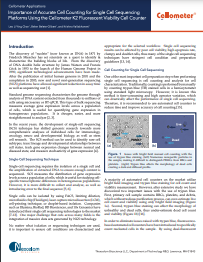Importance of Accurate Cell Counting for Single Cell Sequencing Platforms Using the Cellometer K2 Fluorescent Viability Cell Counter
The discovery of “nuclein” (now known as DNA) in 1871 by
Friedrich Miescher has set scientists on a quest to identify &
characterize the building blocks of life. From the discovery
of DNA double helix structure by James Watson and Francis
Crick in 1953 to the launch of the Human Genome Project in
1990, significant technological advancements have been made.
After the publication of initial human genome in 2001 and the
completion in 2003, new and novel next-generation sequencing
(NGS) platforms have allowed significant reduction in assay time
as well as sequencing cost [1].
Standard genome sequencing characterizes the genome through
analysis of DNA content extracted from thousands to millions of
cells using microarray or RT-qPCR. This type of bulk sequencing
measures average gene expression levels across a population
of cells, which is useful for quantifying gene expression in
homogeneous populations. It is cheaper, easier, and more
straightforward to analyze [2, 3].
In recent years, the development of single-cell sequencing
(SCS) technique has shifted genomic research towards more
comprehensive analyses of individual cells for immunology,
oncology, neuro and developmental biology, as well as stem
cell research. The SCS method can be used to identify rare cell
subtypes, trace lineage and developmental relationships between
cell states, track gene expression changes between normal and
diseased state, and measure stochasticity of gene expression [4].

